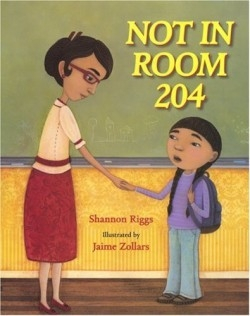Not in Room 204
“Knowing about Stranger Danger is important,” Mrs. Salvador tells her students. “But it’s not always strangers who touch children in ways they shouldn’t be touched. Usually, it’s someone the child knows … I know exactly what to do to help.” Saying just enough but not too much, this important book introduces the difficult subject of child sexual abuse by focusing on how to ask adults for help.
Regina loves the structured safety of Mrs. Salvador’s classroom. She always keeps her desk neat and shakes her head disapprovingly when another student is rude to an aquarium tour guide. She offers to erase the blackboards after school before sadly making her way home for “three whole weeks” of winter vacation, when she will have no respite from the unwelcome attentions of her father. Her mother, a sad-eyed adult version of Regina, does not know that Regina is being abused.
Each of the book’s events occurs in a different month of the school year, allowing both Regina and the reader to become comfortable with Mrs. Salvador and her consistent responses to poor behavior. January’s incident, in which fighting boys are told, “We keep our bodies to ourselves,” sets the stage for February’s annual Stranger Danger lesson. The children slouch in their seats because they hear this material every year, but they become attentive when Mrs. Salvador tells them that most abusers are known to their victims. Children in their school have been abused, and their identities are always kept private. The next morning, Regina arrives at school early to ask Mrs. Salvador for help.
First time author Shannon Riggs, who was interviewed about this book on National Public Radio, tells Regina’s story with carefully meted detail. Her straightforward prose conveys Regina’s isolation and despair, feelings that are equally well-illustrated by Jaime Zollars’ tasteful artwork. Regina’s father is depicted as a shadowy silhouette leaving Regina’s bedroom. In the foreground, Regina huddles under her covers with a tear trickling down one cheek, but her pink pajama top shows clearly above the neatly folded white sheet. Zollars also illustrated The Forest in the Hallway.
It takes courage to speak out about child sexual abuse. This book will be a valuable resource in any classroom or library.
Disclosure: This article is not an endorsement, but a review. The publisher of this book provided free copies of the book to have their book reviewed by a professional reviewer. No fee was paid by the publisher for this review. Foreword Reviews only recommends books that we love. Foreword Magazine, Inc. is disclosing this in accordance with the Federal Trade Commission’s 16 CFR, Part 255.

